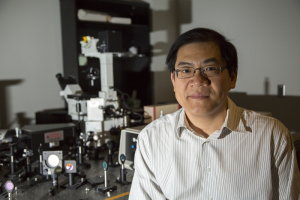The U.S. Department of the Interior’s (DOI) Bureau of Safety and Environmental Enforcement has awarded electrical and computer engineering assistant professor Wei-Chuan Shih with nearly $900,000 over two years to investigate new sensing techniques for detecting oil spills and hydrocarbon leaks in subsea oil and gas operations.
One of the challenges faced by the offshore petroleum sector is monitoring for oil leaks at unmanned production platforms. Current regulations require the companies responsible for these platforms to monitor them for oil leaks on a regular basis. This is typically done by visual inspection carried out on a helicopter – an imperfect solution at best. Helicopters are expensive to operate and cannot fly during the night or under inclement weather, while visual inspections can miss leaks.
In the case of subsea oil and gas operations, which take place hundreds to thousands of feet below the surface of the ocean, leaks often go undetected until the oil reaches the surface of the water. But Shih said he hopes to develop new sensing technologies through this DOI award to detect very small quantities of contaminants such as oil and hydrocarbons in subsea environments.
His idea involves an optical fiber integrated with a gold plasmonic nanostructure consisting of light-excited electrons. Plasmonics enables very strong light-matter interactions near the surface of these gold nanostructures, which Shih said will allow certain “hotspots” along the fiber to interact with particles in the environment. Shih’s group has developed novel highly porous gold nanoparticles with research results published in nearly 10 journal papers over the past two years.
Based on how excited the electrons in the fiber become – that is to say, how much they oscillate in response to a certain interaction – Shih and his team are able to develop what he calls “fingerprints” of various subsea contaminants. “By measuring the returned or transmitted light, one can potentially identify the local chemical and molecular environment,” he explained.
Light-based sensing technologies are Shih’s primary expertise, and he’s been conducting high-level research in this field since he was a graduate student at MIT. As a Ph.D. student in 2005, Shih won MIT’s prestigious Martin Family Fellow for Sustainability award for developing a light-based, non-invasive glucose sensor for diabetes.
After completing his Ph.D., Shih went on to work at Schlumberger, where he developed an automated oil spill monitoring sensor specifically for unmanned, offshore platforms – an invention which won him the best paper award at Schlumberger’s 2008 Reservoir Symposium.
Since joining the electrical and computer engineering department at the UH Cullen College of Engineering, Shih’s research into light-based sensing technologies have won him an NSF CAREER Award and a NASA Early Career Faculty Award. His work is currently funded through grants from the National Science Foundation (NSF), the National Institutes of Health (NIH), the Gulf of Mexico Research Initiative
(GoMRI) and NASA. With the incoming DOI award, his awards collectively total nearly $3 million.
One of the greatest assets of the sensing technologies developed by Shih is their application to a wide variety of fields, from detecting bacteria and disease to sensing environmental hazards such as oil spills. Much of Shih’s ongoing grants support biomedical applications as well as oil leak detection at offshore platforms, but this latest award will allow his group to expand their scope to include subsea chemical sensing.
Shih’s collaborators on the project include Ramanan Krishnamoorti, professor of chemical and biomolecular engineering as well as the university’s chief energy officer, and Zhu Han, associate professor of electrical and computer engineering.
In addition to detecting potentially harmful chemicals at the ocean floor, Shih said the sensors he’s developing will allow his team to study little-understood hydrocarbon-water interactions such as emulsion, wherein water and oil blend together through the constant motion of ocean waves. Emulsion makes the already tedious process of cleaning up an oil spill all the more complicated, and Shih said he hopes the data his team collects will provide insight into more effective remediation efforts after a spill occurs.
Shih also noted that if the technology his team develops is proven to be successful at early detection of oil and hydrocarbon leaks at subsea drilling and production sites, the cost of implementing his sensing system would be negligible compared to the cost of monitoring these sites with helicopter fly-overs, let alone the cost of an offshore oil and gas project.
“This system wouldn’t require any new infrastructure, and the cost to implement it would be very reasonable,” Shih said.
